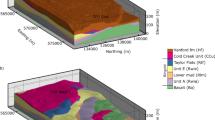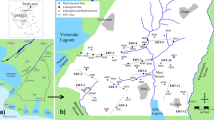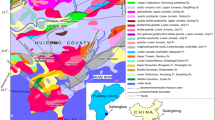Abstract
At contaminated sites, there is a critical reliance on conceptual site models of which a key component is the geologic framework model (GFM), which is used to build predictive fate and transport modeling in support of remediation goals. We detail an ongoing study at a nuclear waste site (Hanford Site, Washington, USA) where surface geophysical methods were used to complement existing borehole information and to help site new boreholes to update and refine the GFM. Ground-based electrical resistivity tomography (ERT), time-domain electromagnetics (TEM), and seismic data was acquired on the Hanford Site’s Central Plateau, where the presence of a hydraulically transmissive subsurface feature, or paleochannel, was suspected but uncertain based on contaminant concentrations at sparsely located boreholes. To assess and compare ERT, TEM, and seismic geophysical datasets, co-located data was acquired in an area where the existing GFM was more certain. Surrounding the suspected paleochannel, ERT and seismic refraction tomography showed similar subsurface structures consistent with a channelized feature. While TEM interpretation was limited in the suspected paleochannel area due to a thick resistive top layer and high electromagnetic noise, TEM showed greater utility in a different area where these factors were less prevalent. Based on the results of quasi-3D ERT inversions, we propose updates to the GFM, including identifying a paleochannel. Further, we evaluate the utility of geophysical methods and examine lessons learned that will be used as a basis for continued characterization efforts to support site management decisions and implementation efforts.
Highlights
• Geophysical methods were used for site characterization of stratigraphic structure
• Co-located geophysical surveys provided an integrated characterization approach
• Geophysical surveys must consider site-specific conditions













Similar content being viewed by others
Data Availability
The datasets generated during and/or analyzed during the current study are available from the corresponding author on reasonable request.
References
Ajo-Franklin JB, Minsley BJ, Daley TM (2006) Applying compactness constraints to seismic traveltime tomography. Massachusetts Institute of Technology
Aki K, Richards PG (2002) Quantitative seismology. University Science Books, New York
Archie GE (1942) The electrical resistivity log as an aid in determining some reservoir characteristics. Petroleum Trans AIME 146:54–62. https://doi.org/10.2118/942054-G
Auken E, Christiansen AV, Kirkegaard C, Fiandaca G, Schamper C, Behroozmand AA, Binley A, Nielsen E, Effersø F, Christensen NB, Sørensen K, Foged N, Vignoli G (2015) An overview of a highly versatile forward and stable inverse algorithm for airborne, ground-based and borehole electromagnetic and electric data. Explor Geophys 46:223–235. https://doi.org/10.1071/eg13097
Auken E, Foged N, Larsen JJ, Lassen KVT, Maurya PK, Dath SM, Eiskjaer TT (2019) tTEM — a towed transient electromagnetic system for detailed 3D imaging of the top 70 m of the subsurface. Geophysics 84:E13–E22. https://doi.org/10.1190/GEO2018-0355.1
Binley A, Hubbard S, Huisman J, Revil A, Robinson D, Singha K, Slater L (2015) Understanding of subsurface processes over multiple scales. Water Resour Res 51:3837–3866. https://doi.org/10.1002/2015WR017016
Binley A, Slater L (2020) Resistivity and induced polarization: theory and applications to the near-surface earth. Cambridge University Press, Cambridge
Bjornstad B, Thorne P, Williams B, Last G, Thomas G, Thompson M, Ludwig J, Lanigan D (2010) Hydrogeologic model for the gable gap area, Hanford Site. Pacific Northwest National Laboratory, Richland
Carnevale M, Hager J (2005) Integrated geophysical method for characterizing hydro-stratigraphy at a contaminated site. SEG Technical Program Expanded Abstracts 2005, 1152–1155
Chambers RO, Kuras O (2002) 3D electrical imaging of known targets at a controlled environmental test site. Environ Geol 41:690–704. https://doi.org/10.1007/s00254-001-0452-4
CHPRC (2010) Testing ground based geophysical techniques to refine electromagnetic surveys north of the 300 area. Hanford, Washington. CH2M Hill Plateau Remediation Company, Richland
CHPRC (2012) Integrated surface geophysical investigation results at liquid effluent retention facility, 200 East Area, Hanford, Washington. CH2M Hill Plateau Remediation Company, Richland
Clement WP (2021) Geophysical site characterization In: Alderton D, Elias S (ed) Encyclopedia of Geology, (2nd edn). Academic, pp 805–814
Clifford J, Binley A (2010) Geophysical characterization of riverbed hydrostratigraphy using electrical resistance tomography. Near Surf Geophys 8:493–501. https://doi.org/10.3997/1873-0604.2010035
Cummins GD (2010) Intepretation of airborne electromagentic and magnetic data in the 600 area. CH2MHill. Plateau Remediation Company, Richland
Dahlin T (1996) 2D resistivity surveying for environmental and engineering applications. First Break 14. https://doi.org/10.3997/1365-2397.1996014
Day-Lewis FD, Singha K, Binley AM (2005) Applying petrophysical models to radar travel time and electrical resistivity tomograms: resolution-dependent limitations. J Geophys Res B: Solid Earth 110:1–17. https://doi.org/10.1029/2004JB003569
Day-Lewis FD, Slater LD, Robinson J, Johnson CD, Terry N, Werkema D (2017) An overview of geophysical technologies appropriate for characterization and monitoring at fractured-rock sites. J Environ Manag 204:2709–2720
Demirkanli I, Freedman V (2021) Adaptive site management strategies for the Hanford central plateau groundwater. Pacific Northwest National Laboratory, Richland
DOE (2002) Standardized stratigraphic nomenclature for post-ringold-formation sediments within the central Pasco basin Richland, Washington
DOE (2020) Hanford Site groundwater monitoring report for 2020
Foti S (2013) Combined use of geophysical methods in site characterization In: (ed) Geotechnical and Geophysical Site Characterization: Proceedings of the 4th International Conference on Site Characterization ISC-4, 1. Taylor & Francis Books Ltd, pp 43–61
Foti S, Hollender F, Garofalo F, Albarello D, Asten M, Bard P-Y, Comina C, Cornou C, Cox B, Di Giulio G, Forbriger T, Hayashi K, Lunedei E, Martin A, Mercerat D, Ohrnberger M, Poggi V, Renalier F, Sicilia D, Socco V (2017) Guidelines for the good practice of surface wave analysis: a product of the InterPACIFIC project. Bull Earthq Eng 16:2367–2420. https://doi.org/10.1007/s10518-017-0206-7
Gephart R (2003) A short history of Hanford waste generation, storage, and release. Pacific Northwest National Laboratory, Richland
Greenspan M, Tschiegg CE (1957) Speed of sound in water by a direct method. J Res Natl Bur Stand 594:249–254
Hammond T, Lupton D (2015) Development of the Hanford south geologic framework model, Hanford Site, Washington. ECF-HANFORD-13-0029, revision 2. CH2M Hill Plateau Remediation Company, Richlan
Hammond TB (2015) Development of the Hanford south geologic framework model. Hanford Site, Washington
Hyde ER, Speece MA, Link CA, Repasky TR, Thompson MD, Miller SF (2011) A seismic landstreamer survey at the Hanford Site, Washington, U.S.A. Environ Eng Geosci 17: 227–239. https://doi.org/10.2113/gseegeosci.17.3.227
Jaysaval P, Robinson JL, Johnson TC (2021) Stratigraphic identification with airborne electromagnetic methods at the Hanford Site, Washington. J Appl Geophys 192:104398. https://doi.org/10.1016/j.jappgeo.2021.104398
Johnson T (2014) E4D: a distributed memory parallel electrical geophysical modeling and inversion code user guide - version 1.0. Pacific Northwest National Laboratory, Richland
Johnson TC, Slater LD, Ntarlagiannis D, Day-Lewis FD, Elwaseif M (2012) Monitoring groundwater-surface water interaction using time-series and time-frequency analysis of transient three-dimensional electrical resistivity changes. Water Resour Res 48:1–13. https://doi.org/10.1029/2012WR011893
Johnson TC, Versteeg R, Thomle J, Hammond G, Chen X, Zachara J (2015) Four-dimensional electrical conductivity monitoring of stage-driven river water instrusion: accounting for water table effects using a transient mesh boundary and conditional inversion constraints. Water Resour Res 51:1–20. https://doi.org/10.1016/0022-1694(68)90080-2
Johnson TC, Versteeg RJ, Ward A, Day-Lewis FD, Revil A (2010) Improved hydrogeophysical characterization and monitoring through parallel modeling and inversion of time-domain resistivity and induced-polarization data. Geophysics 75. https://doi.org/10.1190/1.3475513
Johnson TC, Wellman D (2015) Accurate modelling and inversion of electrical resistivity data in the presence of metallic infrastructure with known location and dimension. Geophysical Journal International 202:1096–1108. https://doi.org/10.1093/gji/ggv206
Last G, Bjornstad B, Thorne P, Mackley R, Horner J, Lanigan D, Parker K, Williams B (2009) Hydrologeology of the Hanford Site central plateau - A status report for the 200 west area. Pacific Northwest National Laboratory, Richland
Linneman DC, Strickland CE, Mangel AR (2021) Compressional wave velocity and effective stress in unsaturated soil: potential application for monitoring moisture conditions in vadose zone sediments. Vadose Zone J 20. https://doi.org/10.1002/vzj2.20143
Martin CJ (2010) Overview of Hanford hydrogeology. Hanford Site Groundwater Monitoring and Performance Report: 2009
Mavko G, Mukerji T, Dvorkin J (2020) The rock physics handbook. Cambridge University Press, Cambridge
Moser TJ (1991) Shortest path calculation of seismic rays. Geophysics 56:59–67
Murray CJ, Last GV, Truex MJ (2005) Review of geophysical techniques to define spatial dstribution of subsurface properties or contaminants. Pacific Northwest National Laboratory, Richland
Oglivy RD, Meldrum PI, Chambers JE, Williams G (2002) The use of 3D electrical resistivity tomography to characterise waste and leachate distribution within a closed landfill, Thriplow, UK. J Environ Eng Geophys 7. https://doi.org/10.4133/JEEG7.1.11
Pasquet S, Bodet L (2017) SWIP: an integrated workflow for surface-wave dispersion inversion and profiling. Geophysics 82:WB47-WB61. https://doi.org/10.1190/GEO2016-0625.1
Redpath BB (2007) Downhole measurements of shear- and compression-wave velocities in boreholes C4993, C4996, C4997 and C4998 at the waste treatment plant DOE Hanford Site. Pacific Northwest National Laboratory, Richland
Robinson J, Johnson T, Slater L (2015) Challenges and opportunities for fractured rock imaging using 3D cross borehole electrical resistivity. Geophysics 80:E49–E61
Robinson JL, Mackley RD, Rockhold ML, Johnson TC, Thomle JN, Johnson CD, Jaysaval P (2020) Geophysical Methods for Stratigraphic Identification. U.S. Department of Energy, Office of Scientific and Technical Information, United States. https://doi.org/10.2172/1810384
Robinson J, Thomle J, McFarland D, Deters K, Rockhold M, Day-Lewis F, Freedman V (2022a) Integration of large-scale electrical imaging into geological framework development and refinement. Environ Process 9(2):21. https://doi.org/10.1007/s40710-022-00570-2
Robinson J, Thomle J, McFarland D, Deters K, Rockhold M, Day-Lewis F, Freedman V (2022b) Correction to: integration of large-scale electrical imaging into geological framework development and refinement. Environ Process 9:45. https://doi.org/10.1007/s40710-022-00596-6
Rohay AC, Brouns TM (2007) Site-specific velocity and density model for the waste treatment plant, Hanford, Washington. Pacific Northwest National Laboratory, Richland
Rucker DF, Levitt MT, Greenwood WJ (2009) Three-dimensional electrical resistivity model of a nuclear waste disposal site. J Appl Geophys 69:150–164. https://doi.org/10.1016/j.jappgeo.2009.09.001
Singha K, Johnson TC, Day-Lewis FD, Slater LD (2022) Electrical imaging for hydrogeology. The Groundwater Project, Guelph
Springer S (2018) Model package report: Central plateau vadose zone geoframework version 1.0, Richland, WA
Springer S (2019) Central plateau vadose zone geoframework. Ch2M Hill Plateau Redmediation Company
St. Clair J (2015) Geophysical investigations of underplating at the Middle American Trench, weathering in the critical zone, and snow water equivalent in seasonal snow, Doctoral thesis submitted at University of Wyoming
Upadhyay RK, Kishore N, Sharma M (2021) Delineation and mapping of palaeochannels using remote sensing, geophysical, and sedimentological techniques: a comprehensive approach. Water Sci 35:100–108. https://doi.org/10.1080/23570008.2021.1941691
Vilhelmsen T, Marker P, Foged N, Wernberg T, Auken E, Christiansen AV, Bauer-Gottwein P, Christensen S, Høyer A-S (2018) A regional scale hydrostratigraphy generated from geophysical data of varying age, type, and quality. Water Resour Manag 33:539–553. https://doi.org/10.1007/s11269-018-2115-1
Wagner FM, Uhlemann S (2021) An overview of multimethod imaging approaches in environmental geophysics. In: Schmelzbach C (ed) Advances in Geophysics, 62. Elsevier, pp 1–72
Wallin EL, Johnson TC, Greenwood WJ, Zachara JM (2013) Imaging high stage river-water intrusion into a contaminated aquifer along a major river corridor using 2-D time-lapse surface electrical resistivity tomography. Water Resour Res 49:1693–1708. https://doi.org/10.1002/wrcr.20119
Ward S (1988) The resistivity and induced polarization methods. Symposium on the Application of Geophysics to Engineering and Environmental Problems, 147-189
Wellman D, Truex M, Johnson T, Bunn A, Golovich E (2013) Deep vadose zone–applied field research initiative fiscal year 2012 annual report. Pacific Northwest National Laboratory, Richland
Wigginton S (2022) Geologic contacts for the Hanford south geoframework model, EMDT-GR-0071 Rev 0.0. U.S. Department of Energy, Hanford Site, Washington
Wilkinson PB, Chambers JE, Meldrum PI, Ogilvy RD, Caunt S (2006) Optimization of array configurations and panel combinations for the detection and imaging of abandoned mineshafts using 3D cross-hole electrical resistivity tomography. J Environ Eng Geophys 11:213–221. https://doi.org/10.2113/JEEG11.3.213
Xu Z, Hariharan J, Passalacqua P, Steel E, Paola C, Michael HA (2021) Linking the surface and subsurface in river deltas—part 2: relating subsurface geometry to groundwater flow behavior. Water Resour Res 57. https://doi.org/10.1029/2020wr029281
Zhi C, Cao W, Wang Z, Li Z (2021) High-arsenic groundwater in paleochannels of the lower Yellow River, China: distribution and genesis mechanisms. Water 13. https://doi.org/10.3390/w13030338
Funding
Funding information is reported under the ‘Statements and Declarations’ section.
Author information
Authors and Affiliations
Contributions
Conceptualization: Judith Robinson; Methodology: Judith Robinson, James St. Clair, Formal analysis: Judith Robinson, James St. Clair, Piyoosh Jaysaval; Field investigation: Jonathan Thomle, James St. Clair, Joaquin Cambeiro, Kelsey Peta; Writing – original draft preparation: Judith Robinson, James St. Clair, Piyoosh Jaysaval; Writing – review and editing: Judith Robinson, James St. Clair, Piyoosh Jaysaval, Fred Day-Lewis; Funding acquisition: Rob Mackley; Supervision: Judith Robinson, Fred Day-Lewis; All authors read and approved the final manuscript.
Corresponding author
Ethics declarations
This document was prepared under the Deep Vadose Zone – Applied Field Research Initiative at Pacific Northwest National Laboratory. The Pacific Northwest National Laboratory is operated by Battelle Memorial Institute for the U.S. Department of Energy under Contract DE-AC05-76RL01830.
Competing/Conflicting Interests
There are no competing or conflicting interests for any authors directly or indirectly related to this work.
Additional information
Publisher’s Note
Springer Nature remains neutral with regard to jurisdictional claims in published maps and institutional affiliations.
Supplementary Information
Below is the link to the electronic supplementary material.
ESM 1
(DOCX 671 KB)
Rights and permissions
Springer Nature or its licensor (e.g. a society or other partner) holds exclusive rights to this article under a publishing agreement with the author(s) or other rightsholder(s); author self-archiving of the accepted manuscript version of this article is solely governed by the terms of such publishing agreement and applicable law.
About this article
Cite this article
Robinson, J., St. Clair, J., Thomle, J. et al. Using Multiple Geophysical Methods to Refine a Stratigraphic Conceptual Site Model at a Nuclear Waste Site. Environ. Process. 10, 16 (2023). https://doi.org/10.1007/s40710-023-00622-1
Received:
Accepted:
Published:
DOI: https://doi.org/10.1007/s40710-023-00622-1




